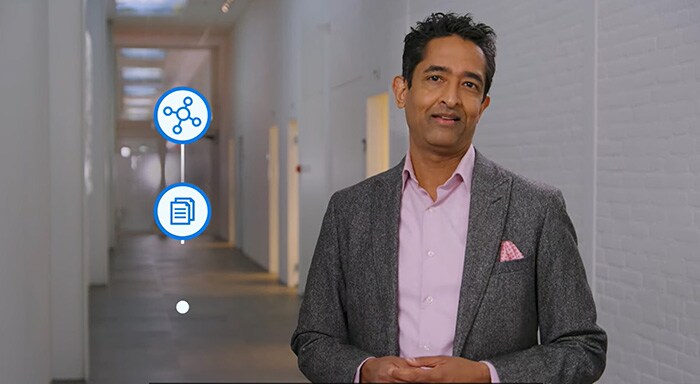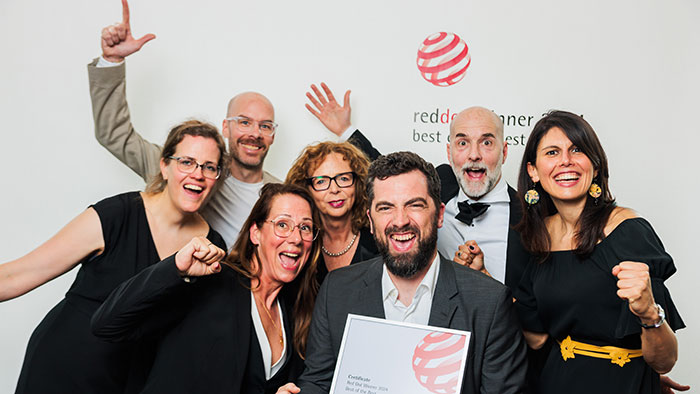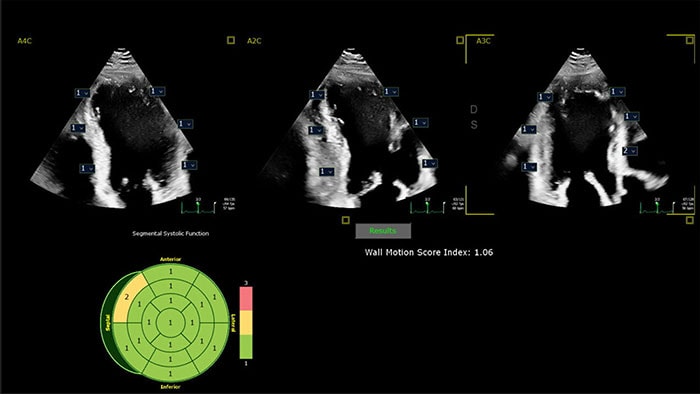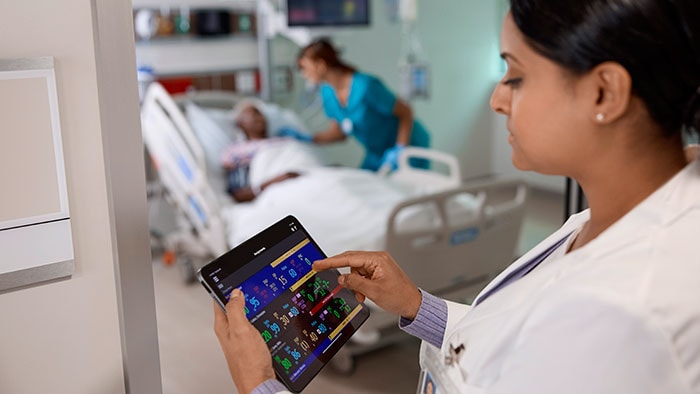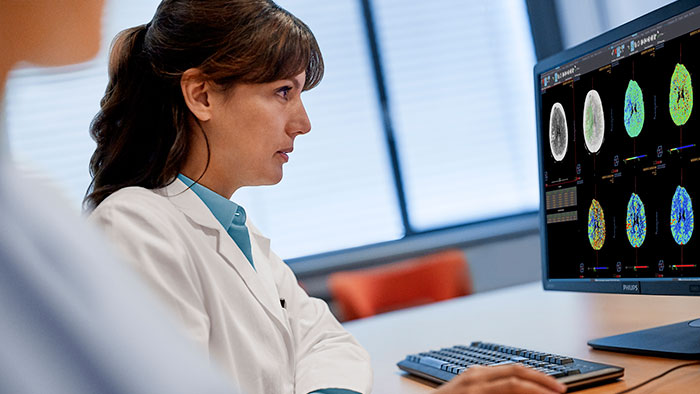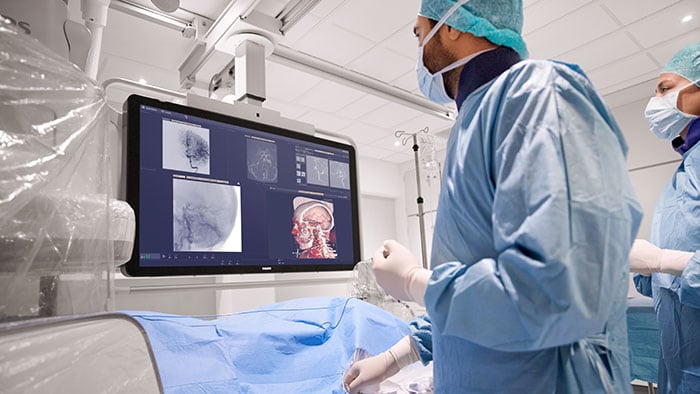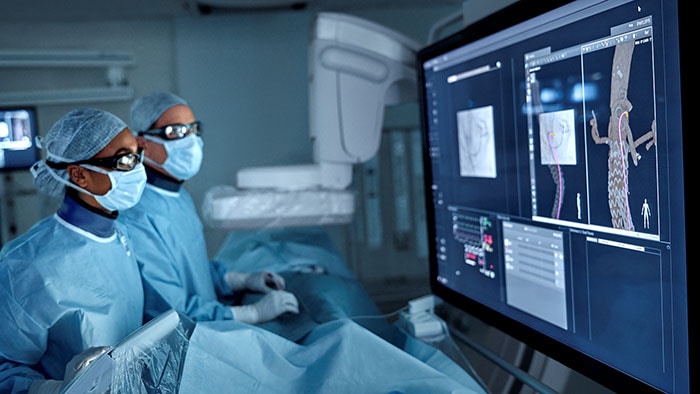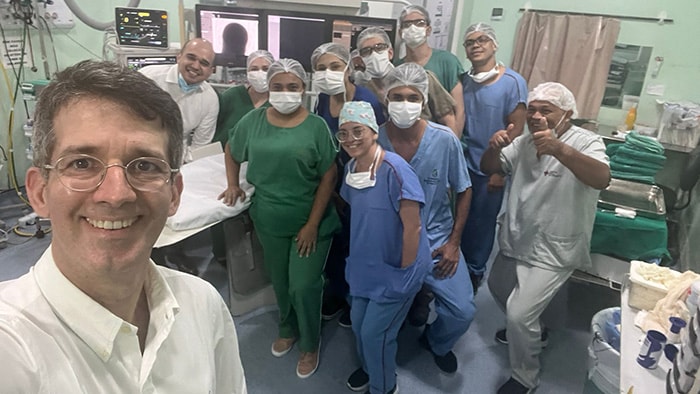Caroline, a 62-year-old active wife and grandmother, loves to paint. Seated at her easel with her pallet of watercolors, it’s her way of unwinding at the end of a busy day. But today, her husband notices something unusual. Caroline is holding her head, unable to focus on the canvas before her. When he asks her what’s wrong, she responds but her speech is slurred. The lower left side of her face and her left arm are drooping, and she has dropped her pallet onto the floor. Having recently attended a first-aid course at work, her husband suspects she may be suffering a stroke. Caroline is exhibiting all three symptoms in the so-called FAST stroke recognition guide - Face, Arm, Speech - and he knows the importance of the last letter in the FAST acronym - Time - so he immediately calls the emergency services and within minutes a paramedic is on the way.
First response
To help assess Caroline’s condition and, if necessary, make advance preparations for her admission to hospital, the paramedic is armed with a Philips Emergency Care Monitor – Tempus Pro – a ruggedized portable patient monitor that enables information about Caroline’s condition to be quickly and easily recorded. Just as importantly, the unit is equipped with Philips Corsium Remote Diagnostics, providing two-way encrypted connectivity to the local healthcare authority’s stroke management center. It means the same information the paramedic records is already being looked at by a neurologist experienced in stroke diagnosis. Based on their joint assessment of the situation, the neurologist instructs the paramedic to transport Caroline to the emergency department in the nearest primary Stroke Center.
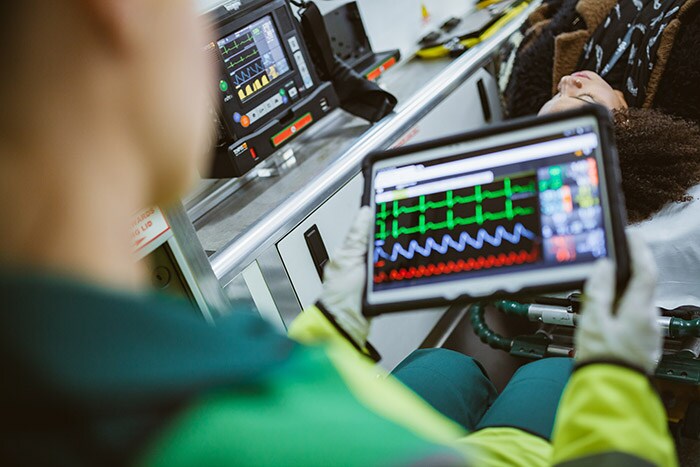
At the click of a mouse, Caroline’s Emergency Care Monitor record is instantly dispatched to the designated emergency department, together with her estimated time of arrival, so they can begin to put together the care team that Caroline will need. Providing solutions that help paramedics triage a patient’s condition and quickly open a line of communication with specialized stroke experts is of utmost importance, both to assist with neurological assessment in the early triage phase and to prepare for the patient’s arrival at hospital so they receive treatment as soon as possible, because the golden rule for stroke is ‘Time-is-Brain’.
Emergency Department Triage
When Caroline arrives at the hospital emergency department, the first thing her care team needs to discover is whether she has suffered a stroke, and just as importantly, which type of stroke. This is because the treatment for hemorrhagic stroke caused by bleeding in the brain is entirely different to that for ischemic stroke caused by restricted blood supply to the brain. It makes diagnostic imaging crucial to the next stage of Caroline’s care pathway.
The emergency room doctor in charge of her care uses Philips remote stroke module to bring together the hospital’s stroke care team and neurologist to evaluate Caroline’s condition and rapidly and expertly manage her condition in the critical minutes and hours ahead. The module’s stroke patient profile screen provides specific stroke care guidelines, a view of all the relevant data to aid decision making, and a timeline to track the time-sensitive metrics of Caroline’s care.
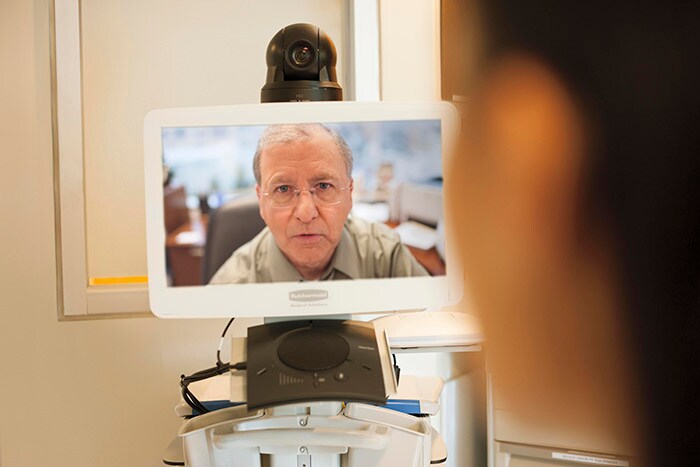
Precision Diagnosis
The first step in the protocol is to rule out a brain hemorrhage, and because the brain can be challenging to image, the team’s radiologist prefers to use a spectral CT for this diagnosis. Spectral CT images help the radiologist to make a more confident assessment by enhancing the visualization of brain tissue. Caroline therefore undergoes a non-contrast (head) CT scan on the hospital’s Philips Spectral CT 7500 scanner.
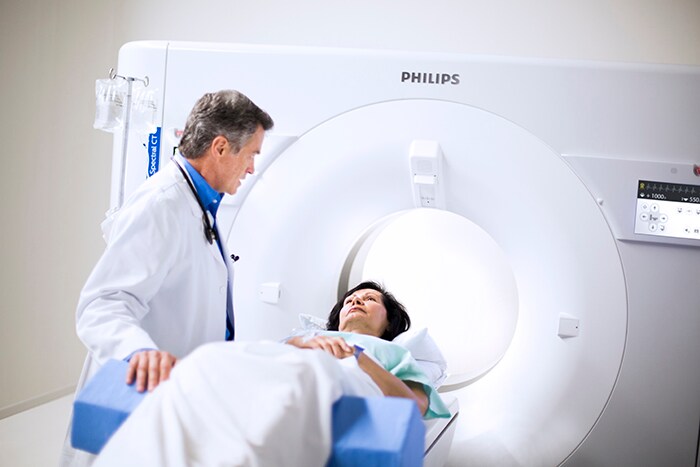
Caroline’s CT scan does not reveal hemorrhaging in her brain, so the radiology team turn their attention to diagnosing an ischemic stroke, often caused by a blocked artery - known as a large vessel occlusion or LVO – that is restricting the brain’s blood supply. Their decision is supported by Nicolab’s StrokeViewer, a cloud-native, intelligent stroke triage and management solution that automatically analyses Caroline’s spectral CT brain scans to identify potential hemorrhaging or ischemia. Although it has not detected hemorrhaging, StrokeViewer has auto-generated an ASPECTS score that suggests a significant level of ischemia in Caroline’s brain. The Alberta Stroke Program Early CT Score is a global quantitative topographic CT scan score based on the identification of ischemic changes in 10 separate brain regions.
Caroline’s ASPECTS score doesn’t look great, but the team still want to confirm a LVO and assess whether Caroline is a good candidate for mechanical thrombectomy – a minimally-invasive procedure to remove the obstruction, typically a blood clot, in the affected artery. To do this, they immediately perform a CT Angiography (CTA) scan to get more data by visualizing the vasculature in her brain.
Based on the CTA images, Philips IntelliSpace Portal - an advanced AI-based visualization platform - provides them with a highly detailed 3D-rendered view of the blood vessels in Caroline’s brain. At the same time, NicoLab’s StrokeViewer automatically detects and localizes a potential LVO in Caroline’s internal carotid artery and sends an automated message to the radiologist confirming its findings. If it is a LVO, it needs fast intervention to avoid permanent brain injury, which means Caroline may need immediate transfer to the nearest comprehensive stroke center where a mechanical thrombectomy procedure can be performed. Using StrokeViewer’s image sharing functionality, the radiologist is able to share all the diagnostic images and the StrokeViewer results with the stroke team at the comprehensive stroke center, where the hospital’s interventional neuro radiologist now has all the patient information readily available to support a definitive diagnosis.
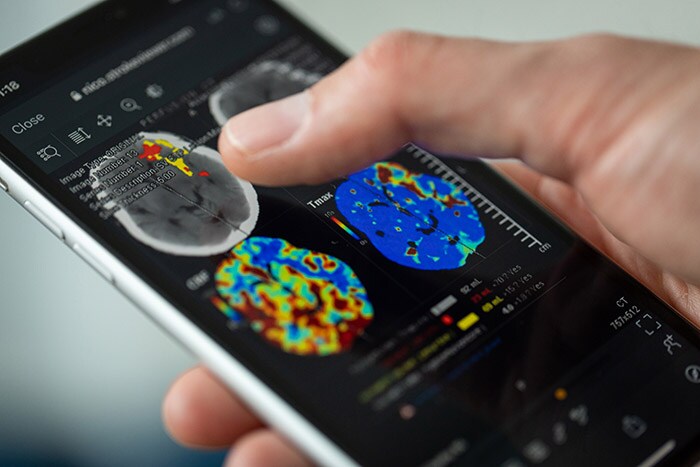
Minimally-invasive Therapy
Based on their collective diagnosis, the physicians can confirm that Caroline has a LVO and can also precisely see its location. It is therefore decided that Caroline needs a mechanical thrombectomy. So the combined team makes the call to transfer Caroline to the nearest comprehensive stoke center where the procedure can be performed. Thanks to StrokeViewer, the comprehensive stroke center’s interventional team can already start to plan the interventional procedure and get everything ready.
By the time Caroline arrives, it means the angio suite where the procedure will be performed has been prepared and the team are already looking at Caroline’s patient record and CT images. The angio suite is equipped with Philips’ Image-Guided Therapy System - Azurion - an advanced image-guided therapy platform that allows interventionists to confidently perform minimally-invasive image-guided procedures such as mechanical thrombectomy by delivering real-time images of a patient’s vascular system as well as the interventional devices, such as catheters and stents, used to effect a repair. Using the system, the interventional team are able to accurately locate the blood clot in Caroline’s carotid artery, guide a catheter to it through her blood vessels via a small incision in her groin, and extract the clot. Once they extract it and restore blood flow to Caroline’s brain, they see an almost instant improvement in her condition. As a follow-up they are once more using Philips Spectral CT 7500. Unlike a conventional CT scanner, the Spectral CT 7500’s spectral detector acquires information in a way that allows physicians to differentiate blood from other materials, such as calcium, making it ideal for use in stroke patients to support treatment evaluation and further follow-up treatment decisions.
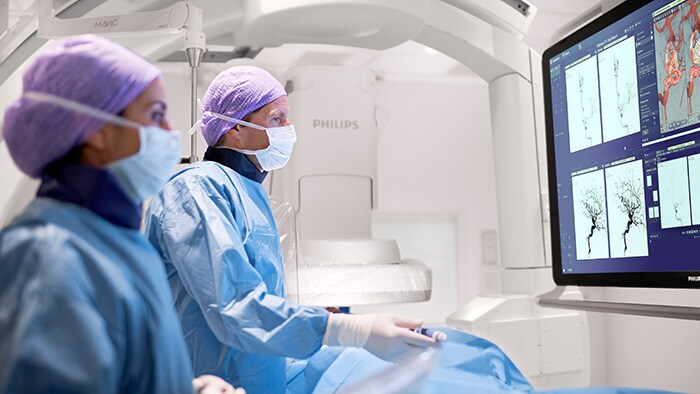
Optimal recovery
Thanks to her husband’s fast response and the streamlined workflow of fast triaging, precision diagnosis, and timely intervention enabled by Philips’ end-to-end stroke management solutions, Caroline’s carotid artery has been unblocked less than four hours after her stroke. With the blood supply to her brain quickly restored, she experiences only mild cognitive and motor impairment. And to make sure she stays that way, Caroline is now wearing a Philips Holter ePatch - an unobtrusive wearable body sensor that will monitor her heartbeat for the next 14 days to detect an abnormal heart rhythm known as atrial fibrillation (AF). Because it’s quite possible that atrial fibrillation was the cause of the blood clot that migrated to her brain and caused her stroke. Fortunately for Caroline there is no sign of AF, so with the help of physiotherapy she is soon back at her painting easel doing what she enjoys most.
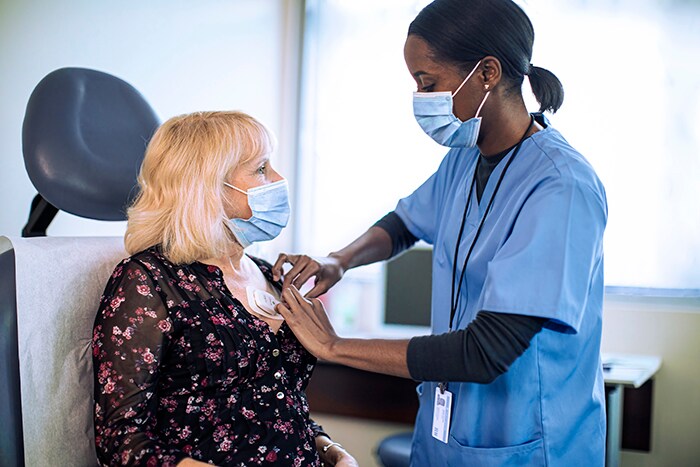
Stroke remains the leading cause of disability
Globally, one in four adults over the age of 25 will suffer a stroke in their lifetime [1]. Stroke is the leading cause of disability and the second leading cause of death worldwide [2]. 40% of stroke victims experience moderate to severe impairments, with another 25% continuing to suffer minor impairments [3].
The key to improving outcomes for stroke patients is to provide treatment as quickly as possible. Physicians in an emergency stroke setting are fighting the clock and are under intense pressure to make optimal treatment decisions. Despite the imperative for speed, care teams currently lose valuable time due to gaps in communication, information, and access to stroke expertise.
Solutions across the stroke care pathway
Philips’ comprehensive stroke suite includes solutions for stroke monitoring and communication in ambulances, tele-stroke patient assessment, diagnostic imaging and analysis, image-guided therapy, neurological monitoring and assessment, and more. These solutions are aimed at improving diagnostic confidence, improving time to treatment, and helping reduce the risk of a second stroke.
You can find more information on Philips stroke suite here.
[1] World Stroke Organization
[2] Global Burden of Stroke, PubMed.
[3] U.S. National Stroke Association
Share on social media
Topics
Contact

Joost Maltha
Philips Global Press Office Tel: +31 6 10 55 8116
You are about to visit a Philips global content page
Continue